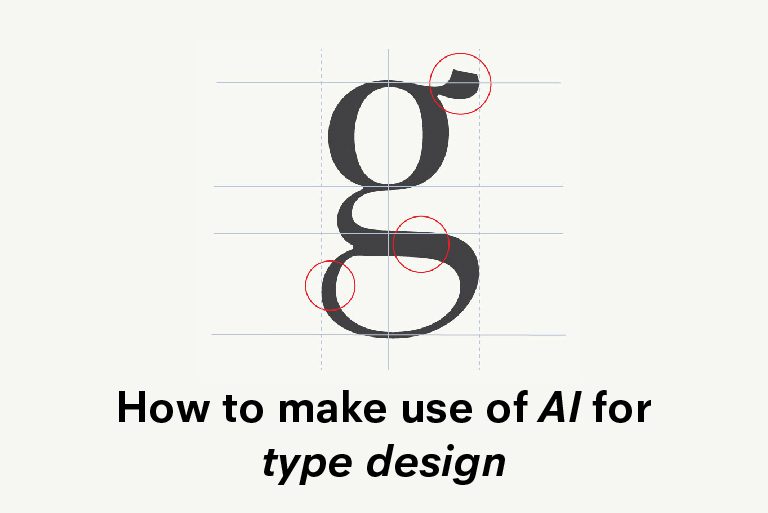AI is revolutionizing our lives and its impact of type design is sure transforming the ways designer’s work. Typography is a field that is deeply rooted in creativity and design, designers, developers, engineers, and brands are actively working to explore the potential of AI to simplify tasks like font pairing and leading to greater efficiency and innovation.
One must take AI as an essential tool in our dynamic digital world today that is used to enhance creativity and experimentation. Designer must leverage AI tools for type design that aid them in their design processes. Here are some ways in which AI aids in type design:
– Automating repetitive tasks
– Generating new fonts using AI based algorithms
– Exploring neural networks for generating unique typefaces
– Building font libraries by training AI models
– Creating custom fonts using style transfer techniques.
Also read: Embracing Voice UI as the future of user experience design
Let’s understand how AI tools help the designer in their process:
A. Neural Networks for generating Fonts
Neural networks are a key component in AI that have proven to be instrumental in font generation. These networks are trained to use vast datasets of existing font libraries allowing them to learn patterns, shapes, lines, structures, and a vast number of typefaces. When designer type in specific structures, shapes, or parameters in the AI tool, it can generate new font style that are original and unique.
Variational autoencoders (VAEs) and generative adversarial networks (GANs) are a couple of generative AI models that enable designers to explore beyond the traditional design convention of design and innovate using new visual aesthetics pushing type expression further ahead.
b. Font identification and pairing
AI-powered font identification tools are now an invaluable asset for designers. This tool will analyse the visual characteristics and the unique attributes of a given font to identify a similar typeface or suggest something that is complimentary in nature.
This tool can help the designers to find apt font style that aids to optimize reading – sharing critical factors like contrast, letterforms and spacing. Designers can make use of this to enhance a reader’s reading experience with enhanced legibility and visual appeal of their type compositions.
Using these tools designers have access to vast repository of fonts to explore from, enabling them to design and create new aesthetically pleasing and compelling combinations.
Read here: Most popular chatGPT AI prompts for designers
c. Automation and efficiency in type design process
AI-tools and software’s help designers to streamline and expedite various aspects of their type design workflow. It essential streamlines the typography workflow by assisting in tasks such as prototyping, iteration and user feedback analysis. Helps to reduce the time and efforts a designer spends on these repetitive tasks. With this designer can focus on experimentation at a faster rate with more efficiency in generating new design by playing with various visual styles, weights, and proportions.
d. Collaboration
AI-tools foster a creative and collaborative environment for designers.
AI-driven platforms facilities a seamless teamwork with real-time feedback, version control and collaborative editing capabilities which enable the designers to work together with their team in a more efficient and effective manner to generative desired results.
Also read: How colour psychology works in packaging design
Global brands utilizing AI for build AI-tools for type design.
IDEO
A global renowned design brand, IDEO, has developed ‘Font Map’ that is one key fascinating tool that visually represents relationships between fonts. It is leveraging a neural network called VGG16 and with certain specific algorithm to extract hidden connections and disparities among close to 800 fonts. The result of this in 3D visual representation offers designers a unique perspective on the relationship between number of typefaces.
Font Map today serves as a creative playground that reveals unexpected connections and inspires designers to explore new innovations within type.
Adobe
Global design brand, Adobe, has leveraged AI to build an AI-tool for type design. They kickstarted project coined ‘Project Faces’ to explore the intersection of AI and type design. With the use of deep learning techniques and neural networks, Adobe trained its AI model on a vast database of existing typefaces, allowing the AI to learn and understand the intricacies of the number of type styles. This aided AI to analyse user input like a desired characteristic and visual preferences to generate a range of custom typefaces to align with the user specifications.
Also read: What a career in metaverse and NFT design can offer
It has incorporated feedback loops that allowed designers to provide input and preference for specific design elements. This tool from Adobe has helped to streamline the design process and shows their commitment to innovate as well as equip others designer with a cutting-edge tool to explore the vast potential in the realm of type.
These examples highlight how the role of AI is only at its native stage and as it continues to evolve, we can expect further advancements. By leveraging AI algorithms, designers can enhance their creativity and explore design variations that were previously unimaginable. However, it is essential to approach AI with a thoughtful and ethical mindset, understanding the implications and potential biases that may arise from AI-generated designs.
Also read: Amul Girl: Longest running and successful ad mascot



Want to Become a Designer ?
Strate is a unique design school that nurtures your talents as a designer by offering state-of-the art designing courses in Bangalore.
Join Strate